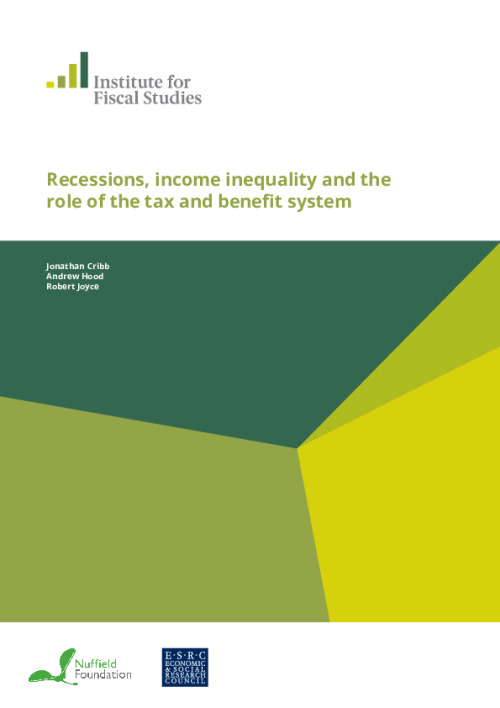It is now around a decade since the financial crisis that triggered the Great Recession of 2008–09. In many respects, the impacts of this recession on the living standards of UK households have been unusually severe. Median household income is now around 15% below its long-run trend, having grown by only around 5% over the past decade. However, one dimension in which the Great Recession has not had a deleterious impact is income inequality.
In this report, we seek to understand why past recessions have had such different effects on income inequality. We also examine the potential impact of the next labour market downturn on the distribution of household incomes.
The effect of past recessions on income inequality
- Across most of the population, income inequality fell significantly during and immediately after the Great Recession. Looking at those aged under 65, net equivalised household income was essentially unchanged in real terms between 2007–08 and 2011–12 at the 20th percentile, but fell by 3.5% at the 80th percentile.
- This is in stark contrast to previous recessions – income inequality rose sharply during and after the early 1980s and early 1990s recessions. For example, again excluding those aged 65 or over, real incomes fell by 5.6% at the 20th percentile between 1979 and 1982, but were almost unchanged at the 80th percentile.
- Differences in the nature of the labour market downturns between different recessions explain most of the differences in the path of income inequality. The early 1980s and early 1990s recessions were characterised by large falls in employment, which acted to increase inequality; in contrast, the large falls in real earnings among those in work after the Great Recession acted to reduce inequality.
The role of the tax and benefit system
- The tax and benefit system played an important role in reducing income inequality during and immediately after the Great Recession. The existence of in-work benefits dampened the effect of falling real earnings on the incomes of low-income working households – there was a 12% fall in household earnings at the 10th percentile but that led to a fall of less than 5% in net household income at the 10th percentile among working households. At the same time, increases in the generosity of some benefits during the recession boosted the incomes of low-income households.
- Over the past few decades, the insurance provided by the tax and benefit system has shifted away from insurance against employment falls towards insurance against earnings falls for those in work. Falls in the value of out-of-work benefits relative to earnings mean households have less insurance against employment falls; but the introduction of tax credits has maintained the insurance that working households have against earnings falls.
- As a result, the public finances are less sensitive to a fall in employment than under previous systems, but no less sensitive to earnings falls. If the employment falls seen in the early 1980s reoccurred today, 55% of the impact on pre-tax earned income would be passed through to households’ net income (with the other 45% borne by the public finances through lower taxes or higher benefits). Under the 1979 system (with all parameters increased in line with earnings), the split would be 50:50.
- The current system provides the most insurance to low-income households and those with three or more children. These groups are least likely to be able to maintain their spending in the face of a fall in net income (they are the most credit constrained), which means, all else equal, there is a stronger case for the state providing insurance. But the flip side of the stronger insurance is that these groups face the weakest financial work incentives.
The impact of planned tax and benefit reforms
- Looking forward, further cuts to working-age benefits will significantly reduce the insurance the tax and benefit system provides against future recessions. By reducing the generosity of working-age benefits, changes that are planned or currently being rolled out will reduce the amount of lost earnings that would be offset by higher benefits in the event of a recession.
- The falls in insurance will be most pronounced for low-income households and those with three or more children. If the earnings falls seen during the Great Recession were repeated today, the poorest 30% of households would only see 39% of those falls passed through to their net income. If all future reforms were fully in place, that pass-through rate would be 53%.











